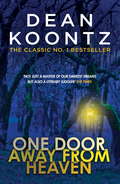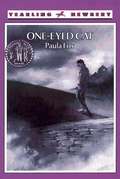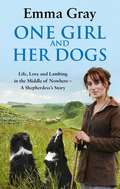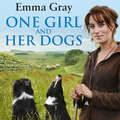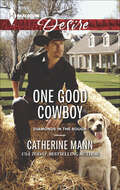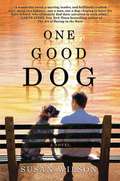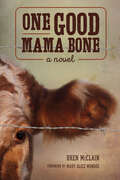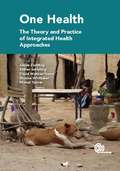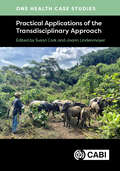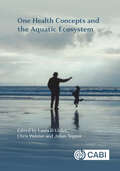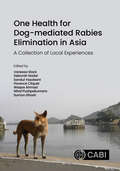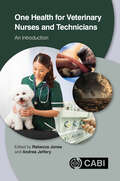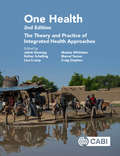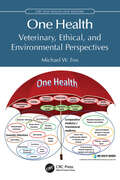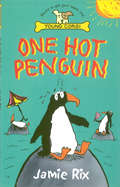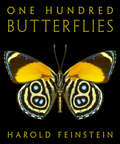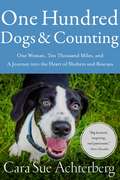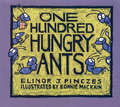- Table View
- List View
One Door Away from Heaven: A superb thriller of redemption, fear and wonder
by Dean KoontzOne young woman risks everything to save a child... Dean Koontz writes an unforgettable tale in One Door Away From Heaven - the thrilling story of a deadly threat, and the young woman who will do anything to stop it. Perfect for fans of Richard Laymon and Harlan Coben.'A wonderful contemporary fable, firmly rooted in the gritty reality of turn of the millennium America... Koontz constantly surprises as his story unfolds and reaches its stunning conclusion. Brilliant and compulsive' - Good Book GuideLeilani Maddoc's tenth birthday is nine months away. Micky Bellsong is convinced that in nine months and one day, the girl will be dead. And no one seems to care but Micky herself.Micky has a history of making wrong choices and living only for her own desires, but her decision to save the child's life - and pit herself against an adversary as fearsome as he is cunning - takes her on a journey of incredible peril and stunning discoveries, a journey filled with tragedy and joy, with humour, terror and hope, a journey that will change her for ever. What readers are saying about One Door Away From Heaven: 'This book is gripping from the very start, with great characters throughout; the slow build up... is absolutely perfect''This book is quite a remarkable read... The plot sizzles along and the characterisation is awesome''A fluid page turner that will make you late for work'
One Eyed Cat
by Paula FoxNed Wallis knows he's forbidden to touch the rifle in the attic. But he can't resist sneaking it out of the house, just once. Before he realizes it, Ned takes a shot at a dark shadow.<P><P> When Ned retums home, he's sure he sees a face looking down at him from the attic window. Who has seen and heard him?<P> Ned's feelings of guilt and fear only get worse when one day, while helping an elderly neighbor, he spots a wild cat with one eye missing. Could this be the thing Ned shot at that night? How can Ned bring himself to reveal his painful secret?<P> Newbery Medal Honor book
One Fine Day
by Nonny HogrogianFrom the book: A delightful telling makes this story of a greedy fox's adventure as catchy as a nursery rhyme. This book was the recipient of the 1972 Caldecott Medal.
One Fox: A Counting Book Thriller
by Kate ReadCounting from one to ten has never been so thrilling in this Ezra Jack Keats New Illustrator Honor Book and recipient of the Mathical Book Prize from Kate Read! One hungry fox with two sly eyes is on the prowl . . . three plump hens had better watch out! Rich and colorful illustrations plunge the reader into a dramatic and exciting story set in a moonlit farmyard. With something different to count on each page, this gripping tale introduces page-turning tension to young readers in an age-appropriate way. Great for early education and read alouds, this fun numbers introduction has a hugely satisfying ending that&’s sure to delight! Pluck up this one up for your little math enthusiast today and check out the available activity kit online. Also by Kate Read: Hey! A Colorful Mystery, a perfect selection on color vocabulary for budding artists. "Stunning... Count on requests for many readings." —School Library Journal, STARRED REVIEW Ezra Jack Keats New Illustrator Honor Book Recipient of the Mathical Book Prize Charlotte Zolotow Award (Highly Commended) Parents&’ Choice Gold Award Recipient An ALSC Notable Children&’s Book A Capitol Choices Noteworthy Book for Children and Teens Cybils (Fiction Picture Books) A Bank Street Best Children's Book of the Year A NYPL Best Book for Kids A CCBC Choice
One Funny Day (Pearl and Wagner #1)
by Kate McmullanAn Easy-to-Read Book.<P><P> Laughter is the best medicine for Pearl and Wagner!<P> Wagner is having a bad day. He oversleeps and is late for school. His best friend, Pearl, his teacher, and even the school librarian are acting very strangely. And the lunch lady is serving bug juice! <P>Why?<P> It's April Fools' Day!<P> But when Pearl picks another partner for the class dance contest, she's not joking around. It's one unfunny day for poor Wagner ... until he dreams up the perfect way to get the last laugh!<P> Winner of the Theodore Seuss Geisel Honor
One Girl And Her Dogs: Life, Love and Lambing in the Middle of Nowhere
by Emma GrayEMMA GRAY'S NEW BOOK 'MY FARMING LIFE' ('A HEARTWARMING TALE OF LIFE ON THE LAND' Alan Titchmarsh) IS OUT NOWWhat happens when you swap 'I do' for pastures new?When twenty-three-year-old shepherdess Emma Gray breaks off her engagement, the chance to take over an isolated Northumberland farm seems just the fresh start she needs. But while the beautiful scenery certainly offers plenty of scope for contemplation, a night out with an eligible bachelor soon seems more remote than the farm itself. And once you add fugitive sheep and freak blizzards into the mix, Emma's dreams of a happy future at Fallowlees Farm quickly begin to fade.Throughout the long nights of lambing, the highs and lows of the local sheepdog trials and the day-to-day chores of maintaining a large, ramshackle farm, Emma's collies are her most loyal companions. With Bill, Fly, Roy and Alfie by her side, she'll never really be alone. Emma's remarkable first year at Fallowlees - the triumphs, the disasters, the heartbreak and the glimmer of romance on the horizon - is an inspiration for anyone who has ever dreamt of changing their life and starting all over again.____________________________________________________________Readers love ONE GIRL AND HER DOGS: 'This is an amazing book, difficult to put down. A must for all thinking of living of the land, or looking to be inspired by a hard working courageous young woman' 'What a little gem of a book, I loved it. Emma has given us a little taste of her life in the remote Fallowlees Farm in Northumberland, her knowledge of lambing is just astonishing to me and her beautiful dogs are amazing, I must admit to shedding a tear now and then, but there was plenty to chuckle at too' 'An admirable book''Very entertaining and readable. A brave girl who made the decision to become a sheep farmer and farm in a lovely and lonely spot''This story is written in such a way that you feel you are actually on the farm and going through the trials too. Wonderful empathy with her dogs and an excellent storyteller'
One Girl And Her Dogs: Life, Love and Lambing in the Middle of Nowhere
by Emma GrayEMMA GRAY'S NEW BOOK 'MY FARMING LIFE' ('A HEARTWARMING TALE OF LIFE ON THE LAND' Alan Titchmarsh) IS OUT NOWWhat happens when you swap 'I do' for pastures new?When twenty-three-year-old shepherdess Emma Gray breaks off her engagement, the chance to take over an isolated Northumberland farm seems just the fresh start she needs. But while the beautiful scenery certainly offers plenty of scope for contemplation, a night out with an eligible bachelor soon seems more remote than the farm itself. And once you add fugitive sheep and freak blizzards into the mix, Emma's dreams of a happy future at Fallowlees Farm quickly begin to fade.Throughout the long nights of lambing, the highs and lows of the local sheepdog trials and the day-to-day chores of maintaining a large, ramshackle farm, Emma's collies are her most loyal companions. With Bill, Fly, Roy and Alfie by her side, she'll never really be alone. Emma's remarkable first year at Fallowlees - the triumphs, the disasters, the heartbreak and the glimmer of romance on the horizon - is an inspiration for anyone who has ever dreamt of changing their life and starting all over again.____________________________________________________________Readers love ONE GIRL AND HER DOGS: 'This is an amazing book, difficult to put down. A must for all thinking of living of the land, or looking to be inspired by a hard working courageous young woman' 'What a little gem of a book, I loved it. Emma has given us a little taste of her life in the remote Fallowlees Farm in Northumberland, her knowledge of lambing is just astonishing to me and her beautiful dogs are amazing, I must admit to shedding a tear now and then, but there was plenty to chuckle at too' 'An admirable book''Very entertaining and readable. A brave girl who made the decision to become a sheep farmer and farm in a lovely and lonely spot''This story is written in such a way that you feel you are actually on the farm and going through the trials too. Wonderful empathy with her dogs and an excellent storyteller'
One Good Cowboy (Diamonds in the Rough #2293)
by Catherine MannA cowboy is reunited with his former fiancé in order to claim his family inheritance in this sexy romance from a USA Today–bestselling author.From ex to eternity?To inherit his family’s empire, Texas cowboy-turned-CEO Stone McNair must prove he has a heart beneath his ruthlessly suave exterior. His trial? Finding homes for his grandmother’s rescue dogs. His judge? Johanna Fletcher, the woman whose heart he broke.Sure, Johanna can handle a week traveling the country with her ex-fiancé to fulfilll his dying grandmother’s request. She and Stone want different things—plain and simple. But there’s nothing plain about Stone, or simple about the heat that still flares between them. One week may not be long enough.
One Good Dog
by Susan WilsonThe story of one man, one dog, and how they save each other in ways they never could have expected.
One Good Horse
by Tom GronebergSince moving west over a decade ago, Tom Groneberg has worked with horses as a trail guide, as a ranch hand, and as the manager of his own ranch in Montana, but he has never owned a really good horse. Until, on an autumn night, in a warm barn under a blanket of snow, Blue is born. Soon, he will belong to Tom Groneberg. "If I had a good horse," writes Tom, "I could give it my life. I could ride it for years. We could grow old together. " So begins this unique American love story about a man and his horse. In straightforward, poetic prose, Tom Groneberg chronicles the early successes and failures of trying to train Blue, earning the animal's trust, and saddling him for the first time. The experience is challenging, but ultimately rewarding for Tom. Through his relationship with the animal, he develops a deeper understanding of the land and his community, and of himself -- as a man, and as a husband and father. In a world in which horses are fast becoming nothing more than warm-blooded lawn ornaments, Tom still believes these animals are important in human lives. At its heart,One Good Horseis about the power of hope, the simple story of a horse and the way people connect with nature and with each other across the generations.
One Good Mama Bone: A Novel (Story River Bks.)
by Bren McClainA mama cow’s devotion to her calf provides lessons in motherhood to a poor Southern woman in this novel of family, survival, and human-animal bonds.South Carolina, 1950s. Homemaker Sarah Creamer has been left to care for young Emerson Bridge, the product of an affair between Sarah’s husband and her best friend. But beyond the deep wound of their betrayal, Sarah is daunted by the prophecy of her mother’s words, seared in her memory since childhood: “You ain’t got you one good mama bone in you, girl.”When Sarah finds Emerson a steer to compete at an upcoming cattle show, the young calf cries in distress on her farm. Miles away, his mother breaks out of a barbed-wire fence to find him. When Sarah finds the young steer contently nursing a large cow, her education in motherhood begins. But Luther Dobbins is desperate to regain his championship cattle dynasty, and he will stop at nothing to win. Emboldened by her budding mama bone, Sarah is committed to victory even after she learns the winning steer’s ultimate fate. Will she too stop at nothing, even if it means betraying her teacher? One Good Mama Bone explores the strengths and limitations of parental love and the ethical dilemmas of raising animals for food.
One Health
by David Waltner-Toews Rea Tschopp Vanessa Racloz Susan Cork Susan C Welburn Bonnie Buntain Bassirou Bonfoh Simon Reid Jakob Zinsstag Carol Rubin Karin Hediger Eric Boa David H Cumming Mahamat Bechir Vreni Jean-Richard Hung Nguyen-Viet Marcel Tanner Solveig Danielsen Andrea Meisser Professor Craig Stephen Esther Schelling Angela Cassidy Monique Lechenne Martin Bunch Maxine WhittakerThe One Health concept of combined veterinary and human health continues to gain momentum, but the supporting literature is sparse. In this book, the origins of the concept are examined and practical content on methodological tools, data gathering, monitoring techniques, study designs, and mathematical models is included. Zoonotic diseases, with discussions of diseases of wildlife, farm animals, domestic pets and humans, and real-world issues such as sanitation, economics, food security and evaluating the success of vaccination programmes are covered in detail. Discussing how to put policy into practice, and with case studies throughout, this book combines research and practice in one broad-ranging volume. Read a chapter for free
One Health Case Studies: Practical Applications of the Transdisciplinary Approach
by Susan Cork and Joann LindenmayerThe One Health Case Studies book is a collection of international case studies showcasing the work of One Health practitioners and their projects. The book explores current areas of One Health, grouped into themes of One Health policy, pests and pathogens, water and the environment, agriculture and food security, and education and community engagement. Looking at a range of different countries, it examines the unique projects being undertaken in Asia, Africa, Oceania, Europe, North and South America and highlights the application of a One Health approach from research conceptualization to policy development and implementation. This book provides an understanding of One Health practice globally through 28 diverse case studies. Each case study is carefully designed with clear aims, expected learning outcomes, and reflective questions to encourage academic mastery and real-world application of knowledge. The book also bridges the gap between theory and practice by offering insights into current One Health best practices, challenges, and opportunities.
One Health Concepts and the Aquatic Ecosystem
by Chris Walster Julius Tepper Laura D. UrdesOceans and other wetlands cover approximately 70% of the Earth's surface and represent some of the most vital and dynamic ecosystems on the planet. These aquatic environments provide essential functions that support both planetary and human well-being - from regulating climate through carbon sequestration and influencing weather patterns, to sustaining biodiversity and supplying food and livelihoods to billions of people. They act as buffers against extreme weather events, nurseries for marine life, and crucial components of global nutrient and water cycles. Despite their critical role, however, oceans and wetlands remain underrepresented in the One Health discourse, which traditionally focuses more on terrestrial ecosystems such as rainforests, agricultural zones, and urban environments. The resilience of these aquatic systems is therefore deeply interlinked with human and animal health and marine pollution. Overfishing, climate-induced ocean acidification, and the spread of aquatic-borne diseases are all pressing issues that have direct and indirect impacts on public health, food security, and socio-economic stability - particularly for coastal and island communities. Recognizing oceans and wetlands as central components of the One Health framework is therefore essential for developing holistic and effective strategies to address public health challenges, and integrating One Health into research, policy, and practice is scientifically necessary and crucial for achieving long-term sustainability and resilience in a rapidly changing world. This book addresses that disparity of integration and tackles the main concepts of One Health using aquatic environments. It thus covers: - Definitions of One Health concepts and the use of One Health in practice; - The value of water-based environments and their importance in the implementation of One Health programs; - Important cross-sectoral topics such as epidemiology, health economics and statistics, biosecurity, governmental policy, food security, and underreported zoonoses. This textbook explores the interconnectedness between aquatic ecosystems and human health through the lens of the One Health approach. It also aligns with a number of the United Nations' Sustainable Development Goals and has been written as an accessible resource for students, researchers, and practitioners working within the One Health framework.
One Health for Dog-mediated Rabies Elimination in Asia: A Collection of Local Experiences
by Scott Newman Elly Hiby David Sutherland Michael Hathaway Mary Elizabeth Miranda Suzanne Barber Ronello Abila Fiaz Ahmad Manzoor Ahmad Genki Arikawa Naila Baig-Ansari Omesh Kumar Bharti Victoria J. Brookes Eric Brum Karoon Chanachai Ashoka Dangolla Katinka De Balogh Timothy John Dizon Kinzang Dukpa Salome Dürr Anna S. Fahrion M. Aftab Gohar Ma. Ricci Gomez Gyanendra Gongal Mary Joy Gordoncillo Nicole Perreras Grande Silja Griss Mangala Gunatilake Katie Hampson Akitoyo Hotta Satoshi Inoue Md Hamidul Islam Niti B. Jadeja S. Anzal Jaffari Wajiha Javed Ananda Jayasinghe Chandrika Jayasinghe Koji Kanda Chiho Kaneko Suwicha Kasemsuwan Pankaj Kc Rabia M. Khan Yumi Kirino Tipsarp Kittisiam Shintaro Kobayashi Hirofumi Kugita Kansuda Leelahapongsathon M. A. Masud Qamer Mahmood Daria Llenaresas Manalo Noel Lee Miranda Naoaki Misawa Yooni Oh K.A.D.N. Perera Oswin Perera Wilaiwan Petsophonsakul Yoenten Phuentshok Ruwini M.S. Pimburage Supalak Prabsriphum Beatriz Puzon Quiambao Sreejith Radhakrishnan Onpawee Sagarasaeranee Naseem Salahuddin Luuk Schoonman Shynie Telmo Lesa Thompson Pasang Tshering Muhammad Rafi Ullah Abi Tamim Vanak Ad Vos Charlotte Warembourg Ewaldus Wera Tikiri Wijayathilaka Omala Wimalaratne Vilaiporn Wongphruksasoong Aya Yajima Takahiko Yoshida Kentaro Yoshii Mirava YusonAlthough an effective human rabies vaccine has existed since 1885, rabies continues to kill an estimated 59,000 people every year. Sixty per cent of these human deaths occur in Asia. The number of animals, especially dogs, who die of rabies is uncalculated. To work towards the global target of eliminating dog-mediated human rabies deaths, the rabies community is applying the One Health approach by jointly focusing on humans and dogs. Written by a multidisciplinary group of scholars and rabies control programme specialists, this book is a collection of experiences and observations on the challenges and successes along the path to rabies control and prevention in Asia. The book: -grounds chapters in solid scientific theory, but retains a direct, practice-focused and inspirational approach; -provides numerous examples of lessons learned and experience-based knowledge gained across countries at different levels of rabies elimination; -brings together and highlights the practices of a strong, international rabies network that works according to the One Health concept. Covering perspectives from almost a dozen Asian countries and a wide range of sectors and disciplines, such as healthcare facilities, veterinary services, laboratories, public health institutes, wildlife research centres and academia, this book is an invaluable resource for rabies practitioners and scholars, but also those working in the wider fields of disease control and cross-sectoral One Health.
One Health for Veterinary Nurses and Technicians: An Introduction
by Helen Ballantyne Emi Barker Paula Boyden Hayley Burdge Kirsty Cavill Marta Costa Carla Finzel Joanna Hockenhull Nicola Lakeman Robyn Lowe Ellie WestThe One Health concept recognizes that the health of humans, animals and the environment are interlinked, and that maintaining optimal health for all is dependent on a collaborative and multidisciplinary approach at a local, national and global level. This book provides information and guidance for veterinary nurses in understanding both the scope of this concept and their role within it. Beginning with an overview of the global issues faced, One Health for Veterinary Nurses and Technicians focuses on providing an insight into how One Health can be applied within a veterinary practice and in the local community. Translating this important concept and making it relevant for veterinary nurses and their clients, this book: - Covers both communicable and non-communicable disease, as well as public health, climate change, sustainability and the importance of the human-animal bond. - Includes case studies to help to translate theory into practice. - Provides questions to help promote discussion and implement change. Reviewing the interrelations between humans, animals and their environment, this book is an approachable and useable introduction to One Health and is suitable for veterinary nurses and students in the clinical and non-clinical environment One Health for Veterinary Nurses and Technicians has been written by contributors based within the United Kingdom. However, the content is applicable to those working internationally within a veterinary environment and will also be of interest to other allied healthcare professionals.
One Health: The Theory and Practice of Integrated Health Approaches
by Barbara Jones Paul Coleman Anna Dean David Waltner-Toews Michael Clarke Iain J. Gordon Rea Tschopp Susan Cork Susan C Welburn Karin Hediger Mahamat Bechir Hung Nguyen-Viet Marcel Tanner Solveig Danielsen Professor Craig Stephen Esther Schelling Angela Cassidy Martin Bunch Maxine Whittaker Dennis C Turner Abigail Woods Michael Bresalier Michel de Garine-Wichatitsky Wiku Adisasmito Cécile Aenishaenslin Seid Mohamed Ali Ian Allen Silvia Alonso Vilda Amir Maurizio Aragrande Sara Babo Martins Zolzaya Baljinnyam William Bazeyo Andrea Beetz Jeffrey Bender Mónica Berger-González Benjamin Blair Barry Blakley Massimo Canali Nakul Chitnis Guéladio Cissé Kathryn C. Conlon Lisa Crump Soledad Cuevas Paula Dominguez-Salas Colleen Duncan Kaylee Errecaborde Patricia Farnese Thomas Fries Samuel Fuhrimann Christa A. Gallagher Ratna B. Gurung Felix Hafner Barbara Häsler Jan Hattendorf Joldoshbek Kasymbekov Julia S. Lankton Huong Le Thi Henrik Lerner Michael Mahero Stephanie Mauti Céline Mbilo Hélène Meier Mary Elizabeth Miranda Vi Nguyen-Viet Brigit Obrist Peter Odermatt Anna Okello Christopher A.L. Oura Katharine Pelican Kristina Pelikan Phuc Pham-Duc Sue Pollock Sangay Rinchen Karma Rinzin Felix Roth Johanne Saint-Charles Alexandra Shaw Jonathan M. Sleeman Woutrina Smith Keira Spinner Katharina D. Stärk Arlette C. Szelecsenyi Tenzin Tenzin Jimmy Tickel Karin Tschanz-Cooke Hoang Van Minh Alain Vandermissen Tu Vu-Van Daniel P. Walsh Sylvia Wanzala Lenke Wettlaufer C. LeAnn White Andreas F. Widmer Hind Yahyaoui Christian ZurbrüggOne Health, the concept of combined veterinary and human health, has now expanded beyond emerging infectious diseases and zoonoses to incorporate a wider suite of health issues. Retaining its interdisciplinary focus which combines theory with practice, this new edition illustrates the contribution of One Health collaborations to real-world issues such as sanitation, economics, food security and vaccination programmes. It includes more non-infectious disease issues and climate change discussion alongside revised case studies and expanded methodology chapters to draw out implications for practice. Promoting an action-based, solutions-oriented approach, One Health: The Theory and Practice of Integrated Health Approaches highlights the lessons learned for both human and animal health professionals and students.
One Health: The Theory and Practice of Integrated Health Approaches
by Rea Tschopp Vanessa Racloz Susan Cork Susan C Welburn Bonnie Buntain Bassirou Bonfoh Simon Reid Carol Rubin Karin Hediger Eric Boa David H Cumming Mahamat Bechir Vreni Jean-Richard Hung Nguyen-Viet Solveig Danielsen Andrea Meisser Professor Craig Stephen Angela Cassidy Monique Lechenne Martin BunchThe One Health concept of combined veterinary and human health continues to gain momentum, but the supporting literature is sparse. In this book, the origins of the concept are examined and practical content on methodological tools, data gathering, monitoring techniques, study designs, and mathematical models is included. Zoonotic diseases, with discussions of diseases of wildlife, farm animals, domestic pets and humans, and real-world issues such as sanitation, economics, food security and evaluating the success of vaccination programmes are covered in detail. Discussing how to put policy into practice, and with case studies throughout, this book combines research and practice in one broad-ranging volume.
One Health: Veterinary, Ethical, and Environmental Perspectives (CRC One Health One Welfare)
by Michael W. FoxThis collection of reflective, critical, philosophical, and practical chapters represents the author’s 60 years as a veterinarian, ethologist, and bioethicist. The rising incidence of zoonotic diseases from farmed animals and wildlife in the expanding human population and so-called reverse zoonoses where humans are infecting other species are existential concerns. These concerns are linked with anthropogenic climate change and our impact on ecosystems which threaten biodiversity and the health and future of Homo sapiens and many other species.These interconnected issues are examined in this book, broadening the scope and agenda of what is currently more narrowly practiced as preventive medicine. The author calls for greater emphasis on holistic preventive health-care maintenance in response to the escalating costs of human and companion animal health problems, the welfare of factory farmed animals, and endangered status of many wild species.Our species now faces a complex existential crisis that must be addressed in an interdisciplinary way, because there are multiple contributing factors; factors that call for the insights of science and bioethics. Fearlessly tackling contentious issues and 'wicked problems,' Dr Michael W. Fox offers an integrated perspective of what One Health looks like on the ground.
One Hot Penguin
by Jamie RixWhen a young boy called Phelan Whelan is taken to the zoo by his mum on a hot summer's day, the last thing he expects is for a small hot penguin to stow away in his rucksack. Phelan soon realizes that Whistler the penguin can't live in his house, and together they plan to find a new home for him. Preferably an island somewhere near the South Pole...
One Hundred Butterflies
by Harold FeinsteinFeinstein, a noted photographer whose works of roses and other flora and fauna are in collections in museums worldwide, turns his lens to the wonders of the creature about which he writes: "The earth laughs with flowers, but it dances with butterflies. " With an introduction to butterflies' role in the ecosystem and the need for conservation by the curator of the Magic Wings Butterfly Conservatory and Gardens (South Deerfield, MA), the oversize volume features exquisite images of butterflies including the starry night, sunset moth, pearly malachite, and zebra longwing; and interspersed tributes to these creatures associated with the soul and rebirth. Captions provide common and scientific names, and home country. Annotation ©2010 Book News, Inc. , Portland, OR (booknews. com)
One Hundred Dogs and Counting: One Woman, Ten Thousand Miles, and A Journey into the Heart of Shelters and Rescues
by Cara Sue AchterbergA challenging foster dog invites an experienced foster mama to explore where the endless stream of unwanted dogs is coming from and how it will ever end.After welcoming her one hundredth foster dog (and her puppies), Cara grabs her best friend, fills a van with donations, and heads south to discover what is really happening in the rural shelters where her foster dogs originate. What she discovers will break her heart and compel her to share the story of heroes and villains and plenty of good dogs, in the hope of changing this world. Cara fosters her most challenging dog yet and she and her husband are pushed to the brink of what they will do to save a dog. Cara wonders why the need seems endless. She hatches a plan to head south on a Thelma & Louise-style road trip. Each stop exposes more of the realities of rural animal shelters. The hopelessness seems unsurmountable until they discover one shelter, deep in South Carolina that has found the answers and is truly a &‘no-kill&’ shelter. One Hundred Dogs and Counting will introduce the reader to many good dogs, but also to inspirational people sacrificing personal lives and fortunes to save deserving animals. It will offer not just the entertaining stories of plenty of loveable good dogs, but the real problem of unwanted animals in our rural shelters, and how the reader can be part of the solution.
One Hundred Hungry Ants
by Elinor J. PinczesThis tale of ants parading toward a picnic is &“one of those rare gems capable of entertaining while it instructs&” (Middlesex News). One hundred hungry ants march off single file to sample a picnic, but when the going gets too slow, they divide into two rows of fifty, then four rows of twenty-five . . . until they take so long that the picnic is gone! &“The unexpected pairing of sophisticated art and light-hearted text lends this book particular distinction.&” —Publishers Weekly &“The illustrations . . . use a pleasing palette and energetic lines to depict ants with highly individual characters.&” —Horn Book
One Hundred Secret Thoughts Cats have about Humans
by Celia HaddonWant to know what our cats really think about us? Cat behaviour expert and bestselling author Celia Haddon reveals one hundred ways our favourite felines work out our weird behaviour - and so gain more cat power over us. The purrfect gift for the cat lover in your life!
